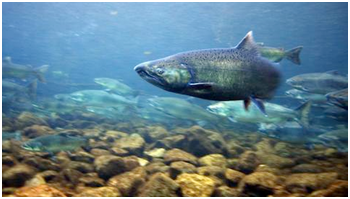Swimming Upstream: Research to Protect Salmon Habitat in the Columbia River
Published May 19, 2020

Understanding how fish navigate in rivers and streams is vital to the management of important keystone species like salmon. EPA works with states, tribes, and university researchers to develop key management strategies for these fish species. Salmon need cold water to migrate up rivers from the ocean for spawning. Sometimes water can get too warm and have negative impacts on fish, including physiological stress, increased metabolic and cardiovascular demands, added disease risk, accelerated maturation, migration delays, and even death. To ensure their spawning success, some salmonids use cold water patches, or refuges, as they make their way upstream.
On the Columbia River, for example, tributaries that collect snowmelt are often sources of the cold water that creates these cold water refuges (CWRs). In Oregon, one of the six Columbia Basin states, the Department of Environmental Quality (DEQ) plays a key role in protecting the state’s water quality. The agency recognized that cold water refuges are important to salmon habitat and included these resources in the agency’s legal framework for water quality standards. Oregon DEQ strives to ensure that cold water refuges are “sufficiently distributed so as to allow salmon and steelhead migration without significant adverse effects. “
EPA scientists, in collaboration with the National Oceanographic and Atmospheric Administration (NOAA), are conducting research to inform policy makers on conditions that affect whether CWRs found within the Columbia River are of sufficient frequency and quality to protect upstream-migrating salmonid species. This goal is particularly challenging due to the increased warming of the Columbia River, which affects the extent to which salmon species rely on the CWRs.
EPA scientists in Corvallis, Oregon, are assisting in this research effort by developing computer simulations of fish populations in the Columbia River system. These researchers are using the EPA tool HexSim to create detailed digital models of these river systems, and to track entire populations of salmon and steelhead as they migrate upstream from Bonneville dam to the confluence of the Columbia and Snake rivers. The simulations track individual fish and keep records of their exposure to river temperatures, and of their changing energy reserves. Modeled fish seek out CWRs when their thermal exposure exceeds species-dependent threshold values. Fish behaviors in the model are calibrated using observations of real fish tracked by partner agencies using telemetry, and model predictions can be tested against observed data as fish migrate upstream. With the help of this model, EPA researchers have been able to explore how changing future river conditions are likely to impact the health of fish that must navigate this portion of the Columbia River. Researchers can simulate fish survival along these corridors using different forecasts for future water temperature and streamflow conditions, different hydropower management options, land use, and restoration scenarios. As new data is collected on survival rates and energy use by fish, the model can be improved to reduce uncertainties. Insights derived from this research are being communicated to managers and policy makers through workshops and published papers and are also incorporated into EPA’s Columbia River cold water refuge plan.
Read more:
